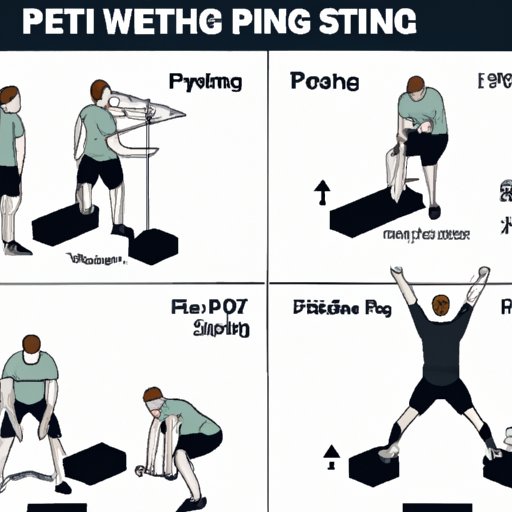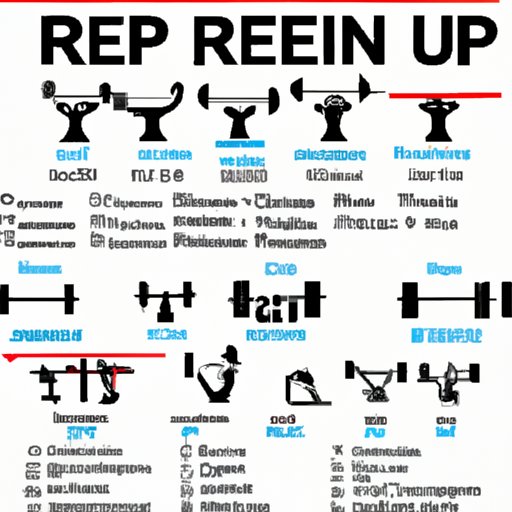Introduction: Exploring the Role of Reps in Exercise
When it comes to getting fit, one of the most important concepts to understand is reps. But what exactly are reps, and why are they so important for achieving your fitness goals? In this article, we’ll explore the basics of reps in exercise, looking at the benefits of both high-rep and low-rep training, as well as tips for properly executing a weightlifting set.
Definition of a Rep
A rep, short for repetition, is a single instance of an exercise movement. For example, if you’re doing a bicep curl with a dumbbell, each time you lift the dumbbell and lower it back down would be considered one rep. The number of reps you do of an exercise is known as your rep count. A typical rep count for a given exercise can range from as few as two reps to as many as 20 or more.

How Reps Benefit Your Workouts
Doing reps of certain exercises can help you reach your fitness goals in several ways. For example, doing reps of exercises that target certain muscle groups can help you build muscle mass and strength. Reps can also help you improve your cardiovascular endurance and burn calories, making them an effective way to lose weight. Finally, reps can help increase your flexibility and mobility, which is especially important if you’re looking to improve your overall athletic performance.
The Benefits of High-Rep Training
High-rep training, which involves doing 15 or more reps of an exercise, can be beneficial for your workouts in a few different ways. According to research published in the Journal of Strength and Conditioning Research, doing higher reps can help increase muscular endurance and reduce fatigue. In addition, high-rep training can help you burn more calories, which is important for those looking to lose weight. Finally, high-rep training can help increase your heart rate and improve your cardiovascular fitness.

What You Should Know About Different Types of Reps in Exercise
When it comes to reps in exercise, there are a few different types you should be aware of. One type of rep is called a “tempo rep,” which involves slowing down the speed of the exercise movement. This type of rep can be helpful for increasing the intensity of your workout and improving muscular control. Another type of rep is called an “isometric rep,” which involves holding a position for a period of time without moving. Isometric reps can help increase muscular strength and stability.
A Beginner’s Guide to Understanding Reps and Sets in Weight Training
If you’re just getting started with weightlifting, it’s important to understand the basics of reps and sets. A set is a group of reps done consecutively. For example, if you’re doing 10 reps of a bicep curl, that would be considered one set. Generally speaking, a typical weightlifting session will involve performing multiple sets of an exercise. The number of sets you do of a given exercise will vary depending on your fitness goals.

How to Properly Execute a Weightlifting Set
When doing a weightlifting set, it’s important to pay attention to form and technique. For example, make sure you’re using the proper weight for the exercise, and that you’re focusing on the correct muscles. It’s also important to use slow and controlled movements, and take rests between sets if needed. Finally, make sure to drink plenty of water before and after your weightlifting session to stay hydrated.
Guidelines for Performing Reps and Sets
It’s important to follow some general guidelines when doing reps and sets. For example, when doing a set, aim to do the same number of reps with each set. Also, make sure you’re not rushing through your reps; take your time to ensure you’re doing them correctly. Finally, listen to your body and don’t push yourself too hard; if you’re feeling any pain or discomfort, stop and rest.
The Power of Low-Rep Training
Low-rep training, which involves doing fewer than five reps of an exercise, can also be beneficial for your workouts. According to research published in the Journal of Applied Physiology, low-rep training can help you increase muscular strength and power. In addition, low-rep training can help increase your bone density, which is important for protecting against osteoporosis. Finally, low-rep training can help you better engage your core muscles, which can help improve your posture and balance.
How to Maximize Results with Low-Rep Training
To get the most out of low-rep training, it’s important to focus on using heavier weights and slower, more controlled movements. You should also pay close attention to your form, and make sure you’re engaging the correct muscles. Finally, make sure to give yourself adequate rest between sets; this will allow your muscles to recover and prepare for the next set.
Conclusion: Putting It All Together
In conclusion, reps are an important part of any exercise program. Doing reps of certain exercises can help you reach your fitness goals, whether it’s building muscle mass, losing weight, or increasing your cardiovascular endurance. High-rep and low-rep training both have their own benefits, and understanding how to properly execute a weightlifting set is key. By following these guidelines, you’ll be able to maximize your results and achieve your fitness goals.
(Note: Is this article not meeting your expectations? Do you have knowledge or insights to share? Unlock new opportunities and expand your reach by joining our authors team. Click Registration to join us and share your expertise with our readers.)
